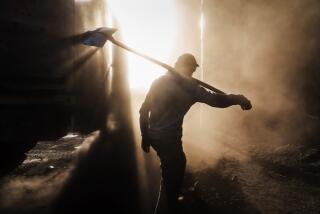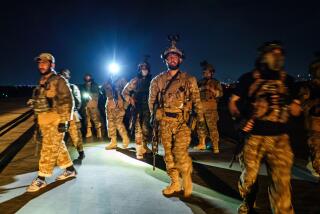Taliban Foes Poised to Seize Northern City
- Share via
TASHKENT, Uzbekistan — Anti-Taliban forces backed by U.S. airstrikes looked close to capturing a key city in northern Afghanistan today, officials with both the opposition Northern Alliance and the Pentagon said.
The seizure of Mazar-i-Sharif, a onetime opposition stronghold that fell to the Taliban three years ago, would be the biggest victory for the alliance since the U.S. began bombing Afghanistan on Oct. 7.
The city could provide an advance staging area or refueling depot for U.S. helicopters and Special Forces units operating out of Khanabad air base in Uzbekistan, about 160 miles to the north.
Seizure of the city and the surrounding countryside could also lead to the opening of a crucial supply route into Afghanistan from Uzbekistan. From Mazar-i-Sharif, the Uzbek border town of Termez is an hour away by road.
Officials of the opposition and residents of Mazar-i-Sharif said Northern Alliance forces fought their way into the city Tuesday.
Mohammed Ibrahim Ghafoori, an official in the Afghan government-in-exile’s embassy in Tashkent, the Uzbek capital, claimed that the alliance could capture the city as early as today.
Pentagon officials said Tuesday that U.S. warplanes were pounding key crossroads near Mazar-i-Sharif, and the officials predicted that the Taliban regime’s forces were close to being overrun.
“They [Taliban forces] are in danger of being cut off right now,” said Marine Lt. Gen. Gregory Newbold, director of operations for the Joint Chiefs of Staff. “Their position could be in jeopardy in the next few days, dependent on what the Northern Alliance decides to do.”
The pelting by U.S. fighter jets and bombers of Taliban positions around Mazar-i-Sharif was part of an intense bombardment of military targets throughout Afghanistan by about 100 U.S. warplanes that began Monday and continued Tuesday and into today. Newbold said the persistent bombardment has “eviscerated” the regime’s fighting power.
Pentagon officials acknowledged that warehouses operated by the International Committee of the Red Cross in the Afghan capital, Kabul, were inadvertently hit Tuesday. No one was killed in the strike.
Residents of Mazar-i-Sharif said the Northern Alliance forces were able to move quickly into the city Tuesday because of U.S. strikes near the town--a sign of close coordination between the U.S. and the alliance.
In the city, as many as 1,000 civilians, said to be fed up with the authoritarian regime, reportedly took weapons from hiding places and began fighting in support of the advancing Northern Alliance troops.
Some Taliban units appeared to be pulling out ahead of the advancing force, said one refugee from Mazar-i-Sharif who is in daily contact with relatives in the city.
“The town is almost captured,” he said. “Maybe by the time the Northern Alliance reaches the center of the city, the Taliban will be gone.”
The city was reported to be quiet Tuesday evening. In some locations, Taliban soldiers could be seen eating their dinners as usual.
There were conflicting reports of how far the Northern Alliance had advanced. And it was unclear whether the Taliban would make a stand and fight the Northern Alliance in Mazar-i-Sharif or retreat along an open route to the west.
“It could be very bloody, but we have no other choice than to fight them,” Ghafoori said.
One of the targets hit by the U.S. strikes Monday was a concentration of Taliban troops near the civilian airport east of the city, opposition forces said. Heavy fighting was reported there Tuesday as the Northern Alliance pushed past the Taliban fighters to enter the city. Some units made it as far as two miles into the city, Ghafoori said.
Another location hit by U.S. bombs was a Taliban base at a military airport about five miles south of the city, the opposition said. That attack helped Northern Alliance troops reach the military airport Tuesday, residents said.
The U.S. strikes Monday and Tuesday included the first use in the air campaign of two AC-130 Spectre gunships that officials said raked the southern Taliban stronghold of Kandahar and at least one other city.
The giant, lumbering craft--specially outfitted cargo planes--were first used in Vietnam but have been updated since with computerized navigation technology. The AC-130 can lay down withering fire from 25-millimeter Gatling guns and 40- and 105-millimeter cannons on two targets at a time.
U.S. officials declined to specify where the AC-130s used in the Afghan mission are currently based. But because the gunship has a range of about 2,000 miles, it could be flying from any of several bases in the Middle East or Central Asia. Aerial refueling could extend its range.
Along with the AC-130 gunships, more than 90 Navy fighter jets from as many as four aircraft carriers and also six to eight Air Force bombers in the region carried out the strikes Monday and into Tuesday, the Joint Chiefs’ Newbold said. American and British warships and submarines fired five to eight Tomahawk cruise missiles as well, Newbold said.
The situation on the ground was changing by the minute. Opposition official Ghafoori, who said his embassy was receiving frequent updates by satellite phone, reported that about 2,000 to 3,000 hard-core Taliban fighters remained in Mazar-i-Sharif.
During Tuesday’s fighting, as many as 400 Taliban fighters surrendered, Ghafoori said. The alliance also captured a large supply of weapons, ammunition and vehicles from the Taliban, he said.
The main Northern Alliance commander at Mazar-i-Sharif is Ata Mohammed, who has been fighting the Taliban in the area for four years. He is said to have at least 5,000 troops.
Another alliance commander, Abdul Rashid Dostum, is farther from the city and is said to be in command of at least 2,000 troops. Dostum, who has a reputation as a brutal warlord, once controlled Mazar-i-Sharif but was forced to flee after one of his deputies betrayed him. Some believe that he hopes to regain control of the city, where thousands of civilians reportedly were slaughtered by the invading Taliban in 1998.
Ghafoori said many of the Taliban fighters are prepared to die rather than surrender. Just before combat, he said, some fighters receive Islamic prayers in a ritual normally reserved for those who have already died.
“Before going to battle, they lie down like they are dead,” he said. “The clergy prays for them, and then they go to battle.”
If the Northern Alliance takes the city and can clear the surrounding region of Taliban fighters, the government of Uzbekistan might agree to open the Friendship Bridge that crosses the Amu Darya River into Afghanistan. The bridge could provide an important route for supplying the anti-Taliban forces.
“After capturing Mazar-i-Sharif, it will take maybe one, two or three weeks to open the bridge,” Ghafoori said. “It is not sufficient to capture Mazar-i-Sharif. We also need to control surrounding areas.”
He said the Afghan government-in-exile has good relations with the Uzbek government, which hopes to crush the Islamic Movement of Uzbekistan, a fundamentalist organization with ties to Osama bin Laden.
“We have close contact with the Uzbekistan government,” Ghafoori said. “They are very cooperative with us. We don’t have any problems with the Uzbek side.”
Many have been surprised by the sudden close cooperation between the U.S. and Uzbekistan, but it is rooted in the former Soviet republic’s own fears of extremist Islam.
The Islamic Movement of Uzbekistan, which is estimated to have more than 2,000 armed members, says it wants to establish an Islamic state in the border region of eastern Uzbekistan.
The U.S. and Uzbek governments say the group is linked to Bin Laden. Bombing attacks in Tashkent in 1999 were blamed on the organization, although it has denied any responsibility.
Repression of the group has been severe in Uzbekistan, and it is believed to have moved into Afghanistan and to be fighting on the side of the Taliban. Three members of the group were reported killed in Mazar-i-Sharif in fighting earlier this week.
*
Paddock reported from Tashkent and Schrader from Washington.
More to Read
Sign up for Essential California
The most important California stories and recommendations in your inbox every morning.
You may occasionally receive promotional content from the Los Angeles Times.










